
 Production Reference:
Production Reference:Translator's Note: The following is a behind-the-scenes account of the production of Mobile Suit Gundam F91 by setting manager Koichi Inoue. It appeared in Mobile Suit Gundam F91: The Official Edition, published by Bandai in May 1991, and it's so full of interesting trivia that I've translated the entire thing.
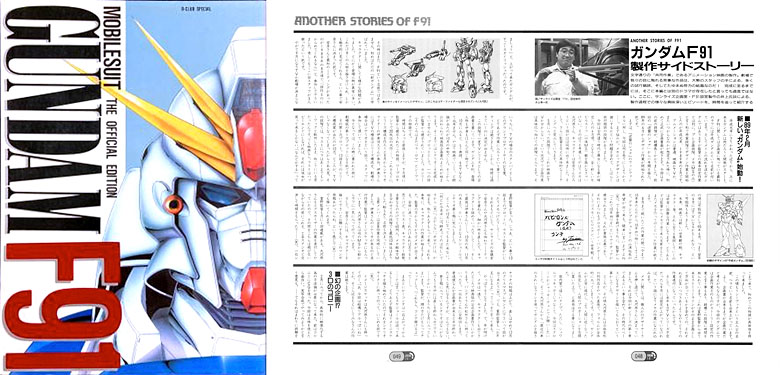
The production history of Gundam F91 is also documented in a few other sources, some of which include dates for specific drafts of the character and mobile suit designs, allowing us to cross-check Inoue's chronology. In some cases he seems to be jumping around in time, and I've included some footnotes to clarify the timing of certain events.
The following text is copyright © Sotsu • Sunrise.
The production of an animated film is literally a "group work." The magnificent work we see in the theater is the distillation of endless trial and error, and tireless effort, at the hands of a huge staff! It's no exaggeration to say that, in its journey to completion, there is a drama entirely distinct from the movie itself. Here, Mr. Inoue of the Sunrise Planning Office, the setting manager for F91, presents various interesting episodes from the production process in chronological order.
Story / Sunrise Planning Office F91 Setting Manager
Mr. Koichi Inoue
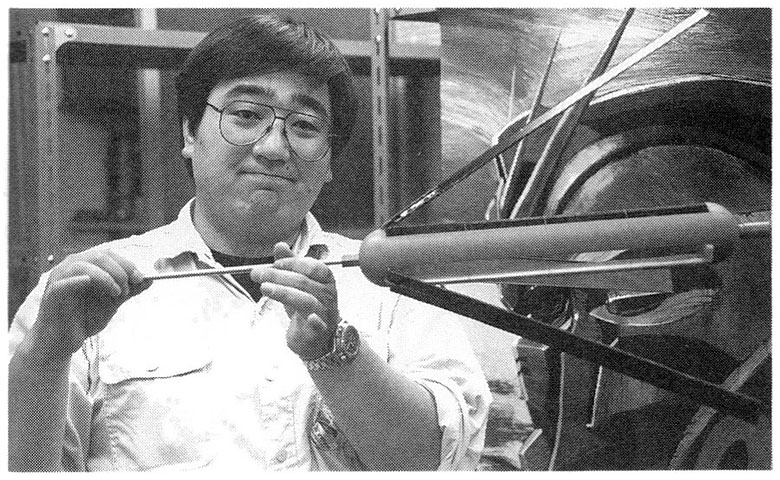
As the calendar changed over to the first year of Heisei, development began to determine what the next upcoming Gundam would be.
The very earliest rough related to F91 that remains in the planning office has the name "Heisei Gundam" attached to it. Though it was a Gundam following the main tradition, this was separate from the basic setting work being done by the director. The design work in this pre-planning stage, and the preliminary draft stage in terms of mecha (mobile suits only), began in February 1989, the first year of Heisei.
Normally, animation starts with a formal proposal that assumes it will be either a movie or a TV series, and when it will start. In this case, the stage before that took a fairly long time. Design work began in April 1989, a year after the previous Char's Counterattack. First of all, we worried about what selling point we could offer this time to compare with the fin funnels of Char's Counterattack. For the time being, the mechanical design was in a trial-and-error stage, including the question of who would do it.
Around April, it was determined that this work would take place in a completely different era and story setting. Thus we would have to create an entirely new view of the mobile suit. Considering such issues, the idea of having Mr. Okawara do the mecha and Mr. Yasuhiko do the characters naturally emerged at roughly the same time. We then embarked on concrete meetings with the director.
Even as May began, we didn't know whether it would be a movie or a TV series. It was under these conditions that the planning work entered a stage in which it would become more concrete. At this point it was still possible that it could become a TV series in April 1990, in other words April of the following year.
Normally, it would be extremely difficult to fully develop a new worldview, enemies, and characters in a movie. For the time being, the work continued based on passages from the director's memos, with further memos being produced in response.
As this work continued into August, the grand producer, President [Eiji] Yamaura, expressed the wish that, "Since we've come ten years to this point, let's make something that will last ten more years." Easy to say! (laughs) But as the meetings continued, the director presented an idea, saying "With this, we can last ten years." This was the doctrine of aristocracy, and the Crossbone Vanguard associated with it, as well as the worldview of Cosmo Babylonia. At this point, the story first became concrete. The main character's name "Seabook," and the name "Berah," were also created around this time.
Left: Early "Heisei Gundam" design (Ishigaki).
Right: This is how the early storyboards were titled.
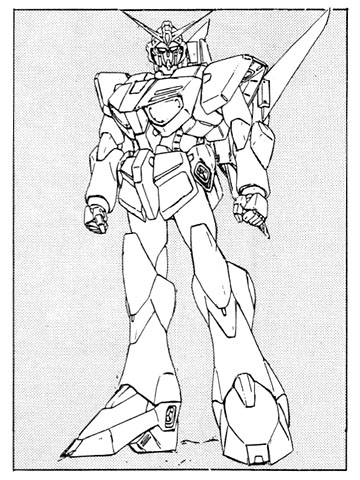
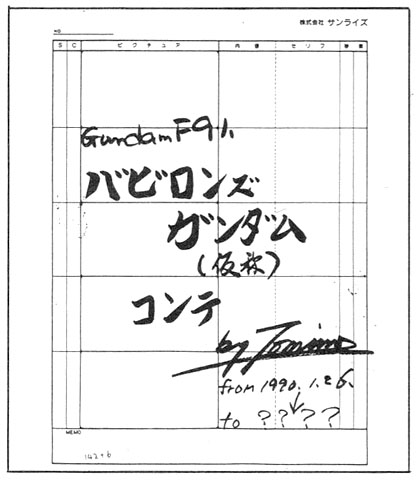
One might think that planning work would simply lead up to the creation of the proposal, but for this Gundam the planning work included working on the story setting, and so this stage took quite a long time. This was because the work progressed through a series of back-and-forth exchanges, including the question of whether the storyline created by Director Tomino matched the direction of the project.
It became clear that if a TV series were scheduled for April of the following year, the setting would have to be created by September, and so we plunged into working on the mecha. When it came to mecha, we passed over several designers and settled on Mr. Okawara. Given that this was the first chapter in a new series, we wanted him to draw the design that would be the basis for this era.
However, Mr. Okawara had just been working on another series involving combining and transforming machines, and his forms ended up being generally weighty. If the Gundam evolved normally, one would assume it would become more humanoid, and so we placed a new order with a request to bear human proportions in mind. Though it was a strong and muscular type, we said, this time we'd like a Stallone or a Jackie Chan rather than a Schwarzenegger. Mr. Okawara then created a really stylish Gundam, saying "I'm going to draw a Gundam using the beautiful lines of modern automobiles." (1)
The name F91 didn't yet exist at this point. In the beginning it was simply called "new Gundam."
A design inspired by the lines of automobiles. At this point a Core Fighter was also assumed. (Okawara)
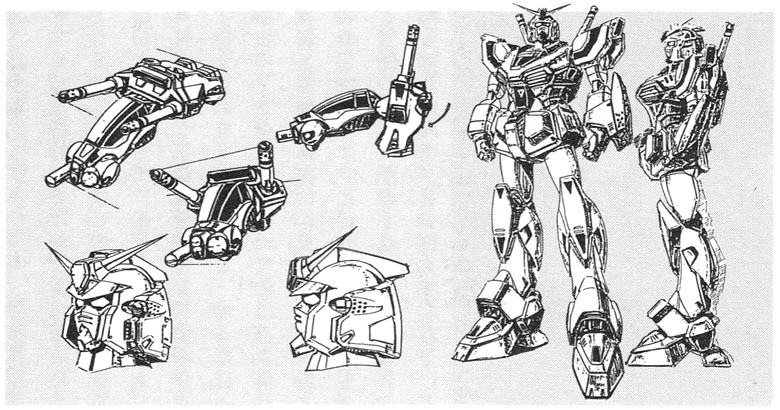
There were also some issues with the characters. In general, there were an unusually large number of them. Mr. Yasuhiko was chosen as a person who could differentiate so many characters, and make them look appealing as well. In our first meeting with Mr. Yasuhiko around August 1989, we said, "You're working on your own stories, but if you could get involved..." and he agreed to participate. Somehow, we had reassembled three members of the original staff.
Soon it was September. Though we hadn't decided between a TV series and a theatrical feature, the word from the grand producer was that we should prepare for the TV option. For the time being, meetings continued on the assumption that work was about to start. Time was passing, but there was still no decision.
At this stage, a proposal was written for a TV series. The characters and content were roughly the same as those of the eventual Gundam F91.
By the time October began, it was hopeless. An April TV series was impossible. In mid-October, the conclusion was reached that we'd have to do a movie after all. After that, we began working feverishly to put together a proposal for the movie version. At this point the script hadn't been completed, but the director suggested one particular story for the plot. This was the story of Cecily (still called Berah Romah at the time) and Seabook.
I'm going back and forth in time a little, but around July, the director had presented this story in the form of 20 or so densely packed word-processor pages. In August, the scriptwriter Tsunehisa Ito joined the project to create a series structure based on this. Mr. Ito agreed to join the staff on the understanding that he'd write the series structure for TV, or the script in the case of a theatrical feature. We can now see how the story written back then became the initial plot for the movie version.
This initial plot, the series structure up to episode 13, was created in October. But if it wasn't going to become a TV series, there was a big problem. At this stage, it ended with Berah being firmly hostile to Seabook, so they'd be separated. But for a movie, we had to have a happy ending, so we needed her to come back. "I'll come up with something," the director said. And so the director began adding memos to the 13-episode plot as he tinkered with the ending...
Based on this, we held a series of meetings in the Sunrise conference room, including Mr. Yasuhiko and Mr. Okawara as well. We were fixing small details, working out the characters... And finally, there was Mr. Ito. At the end of October, he embarked on the first draft of the script, with a tight deadline of the end of November.
As December began, however, the script still hadn't arrived. "I'll do it this month, no matter what. December is always busy. (laughs)" But it wasn't finished. Though it was only half done, character work began using this as reference. The director immediately began writing memos, too, making lists of what would be sufficient to cover the entire story. Totaling up all the characters, the major ones alone amounted to forty people. And at this stage there were at least ten mecha, including mobile suits from both sides. There would also be ships, whose names had now been decided.
All the main staff members were working simultaneously. While Mr. Ito's script was on its way, the director began doing image sketches in parallel, and Mr. Okawara immediately started working on roughs of other mobile suits and ships. When we asked Mr. Yasuhiko to draw the characters, it always seemed like he had manga manuscripts to finish first (laughs)... He did draw them, though.
Director Tomino was also doing a monthly serial, and Mr. Okawara was working on Exkizer at the same time, so meanwhile we were rushing around negotiating with each of the studios for more time, saying "Let's do this before that..." (laughs) We were hearing that the first script draft was tentatively complete, and would at least be revised in time for a December Christmas present. (laughs) But Director Tomino was quietly saying, "It's going to be a New Year's gift."
So it was. And as the new year began, the mecha and characters were more or less done, and so the official proposal for the movie version could be created. We brought it to Bandai and Shochiku, and it was passed back and forth for a while. Normally, I feel like we're halfway done once the proposal is finished, but not this time.
The script was now in its second draft, but even though we asked that the revisions be finished during January no matter what, February was approaching. As he checked the first part that he had received, the director said, "I can draw storyboards from this."
Hmm, if we at least had tentative storyboards... still, the schedule was closing in. For the time being, the director was drawing image sketches, which we brought over to the scriptwriter to prod him along. (laughs)
We also brought the image sketches to Mr. Okawara. "Ah, this time it's pretty realistic," he said. Everyone kept on working with this as a basis.
With February approaching, it had become necessary to devise a concrete methodology for filming. Previously, CG had been used for colonies. This time, it might be interesting to use a three-dimensional model. There was also a view that we should try a live-action composite, but this may have led to some misunderstandings. "Gundam is finally becoming live-action?" Oh really? Who's doing it? "If that happens, it would be nice if they'd give us some money," the producer said. (laughs)
We decided to do it purely as a test, without assuming that we'd use it.
What scale should we make it in relation to an actual colony, and if it actually rotates, then at what speed? How big are the mobile suits approaching the colony? We had to figure all this out.
Producer [Hironori] Nakagawa said, "The production expenses won't cover it." The grand producer told us, "Sunrise will do it! Charge it to planning expenses." But in the end, it was actually included in the production expenses. (laughs) We suddenly had a go sign. So we asked the modeling team Max Factory if they'd like to build a Gundam colony. They asked, "What scale?" How about an overall length of 6 meters? "If you were actually filming it to look like a special effect, 40 centimeters would be enough." Then please do that, we said. Nonetheless, we also wanted close-up images of the colony, so we asked them to make two models. This conversation took place in December.
At first, completion was scheduled for January 20, but it was delayed until January 28. There were various complications even in the building stage.
What should we use as reference for how we build the three-dimensional model? If we built it normally, the mobile suits would be only millimeters in size. (2) We were adding three kinds of patterns—added protrusions, carved grooves, and purely printed elements... At last the model was completed, and we immediately took it to Tokyo Laboratory in Chofu. Here we did some tests using their MAC-1 motion control camera.
By this point the art director Mr. [Shigemi] Ikeda, who had worked on ZZ, Char's Counterattack, and War in the Pocket, had joined the project. The harmony between Mr. Ikeda and Director Tomino was wonderful to see. "What if they break the glass around here so they can go in and out?" "How about this kind of frame construction?" The director would come up with ideas like that and write memos, then Mr. Ikeda would respond, "Then how about this?" or "Yeah, that's good."
One day, Mr. Ikeda handed him a scroll, saying "I made something like this." It was an aerial photograph of a colony, made using a certain photo book as reference. A colony is a single continent whose land is separated by rivers, with three of each running alternately side by side. If you spread it out, the land would be 40 kilometers long by 1.5 kilometers wide. (3) It was interesting that it was so weirdly long and narrow. Since there are hemispheres at the ends, it's actually 6 kilometers shorter, for a length of 34 kilometers. Starting from the mountain area, he'd put in a downtown, a general commercial district, a residential area, and an academic school district. The map showed where all the roads would run and how each of them connected together. This was passed on directly to Max Factory.
Could we put all this inside a 40-centimeter model? "Sure, if you're spending hundreds of millions." (laughs) We said our budget was low for the time being, and they decided to try it anyway. So we all rushed over to take a look.
Left: Mr. Inoue holds up the colony map.
Center: The colony model. This is a million-yen product!
Right: Model of the colony surface. It's just like Star Wars!
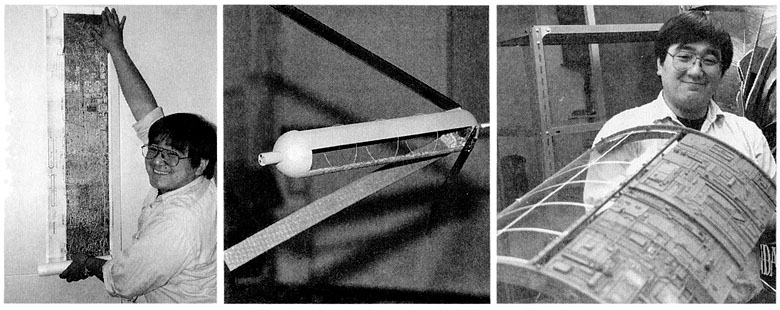
The motion camera wasn't as easy to operate as one might think. In order to retrace something under computer control, two operators had to work very hard at the processing station. That's how it felt, anyway. In space, there's actually only a single light source, so we tried changing the lighting around. Meanwhile, the parts that were receiving the light's heat began undergoing thermal expansion and popping out of place. (laughs) Seeing this, the modelers instantly said, "Oh, it's more realistic if the iron pieces stick out there."
By trying this, we came to understand many things. Mobile suits had always flown around rapidly, but when we calculated their speed, it exceeded Mach 40. In fact, they were approaching at almost a fraction of the speed of light. Up until now, that's how fast they'd been flying. (laughs) Only a few seconds elapsed between when the colony first appeared as a dot, and when they zoomed up to it and landed on its surface. This was actually a terrible lie.
Is the range at which a colony can be seen as a dot tens of kilometers, or hundreds of kilometers? When you rush in from this distance and land, how long does that take? If you can see the colony with your own eyes, then looking at it from here is equivalent to this distance. It was excellent reference.
What's more, when we recorded the rotating colony from various camera angles, we better understood how its curved surfaces turned away in perspective. And, adjusting the angles of the mirrors to match the setting, we better understood how they turned now that we could actually see it. "The ends of the mirrors are moving faster than Mach 2!" (laughs)
Anyway, we'd finished our filming. "It's so realistic. If we put mobile suit cels in front of this, it'll look too cool." Was a live-action composite impossible?
Mr. Ikeda, the art director, said, "In that case, why don't we paint it into the background?" But the director said, "You're really good, Ikeda. But all the other background artists will have to do it too." No matter how many times they had this conversation, they couldn't find a way to make the work any easier.
We told Mr. [Max] Watanabe of Max Factory that we'd leave the model with him, as previously promised. No, he said, I'll finish this here. Suddenly, his airbrush started blowing right there in Studio 2. Saying that he hoped it would be helpful as reference, Mr. Watanabe gave it to us. Using an M1 Abrams model as reference for background technique, he said that if you paint something like this, it will look like that. And indeed, he had given us a sample that Mr. Ikeda could use whenever he was painting backgrounds with his brush, looking at the tank against the colony surface and applying the same kind of treatment. He'd look at the sample and say, I see.
When we filmed the completed model, nothing came of it. If we stopped it moving, it just looked like an ordinary background. But when it moved, it had a curious depth, and the perspective shifted. It was the real thing, after all.
Would we use it or not? We seriously agonized over this. The unit directors suggested that CG might be more suitable for anime. Whatever we did, it was clear that the work ahead would be difficult, and so we regretfully shelved it for the time being. But later on, the director and the grand producer came over to the planning side and said, "We can't let you just throw it away like this." We'd already put it in the budget, so couldn't we use it for something? (laughs)
This was a later development, but the 0083 staff also came to photograph the model, and their work proceeded using those pictures as reference. In that sense, by putting the colonies of the current Gundam world before our eyes for the first time in a proper form, it really was a useful reference. This object now resides in the planning office.
Left: As well as an image rough of Cecily's costume, Director Tomino also created detailed setting for all the ethnic costumes in the beauty contest.
Right: Conceptual diagram of the war museum. There's setting even for locations that aren't shown onscreen.
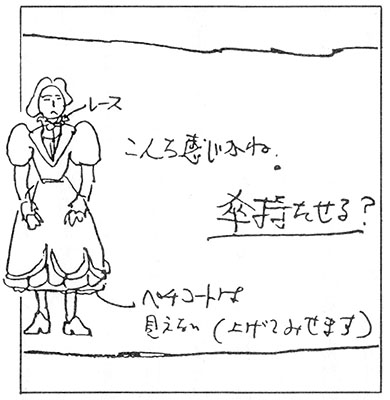
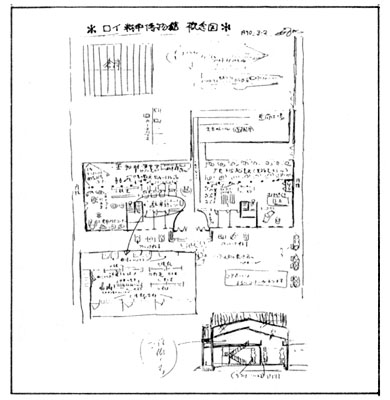
Meanwhile, the second script draft was done. (4) The director could now check the actual script, but he still wasn't satisfied, and a third draft began. In terms of the schedule, though, we were at the limit.
It would normally be very strange to start storyboarding before the script was completed. But considering the remaining schedule, there was no choice, as we wanted to begin animating right away. Thus the director began drawing storyboards, saying that the first half would work as is. (5) We asked when they would be done, and he answered, "Well, from the 10th to the 12th or thereabouts. I'll get them to you by the 15th." In the meantime, I was reassured, and began chasing down the mecha and so forth so we could get moving as soon as they arrived.
In fact, the grinning director appeared at the studio on February 7. "Right," he said as he made his delivery. "Storyboards. Here are storyboards!" But I'm sure you only started at the end of January, director? "That's right." You must be joking, I said. You couldn't bring us all this so quickly. "But I did it!" Suddenly, he'd turned sulky. That's Director Tomino's particular way of showing embarrassment.
I took a look, and he really had finished them. The drawing was solid. They began with mobile suits flying about as they approached a rotating colony. It was great! "That's it so far. Can we start animating now? You said we could finish the setting in a week." Director Tomino laughed wickedly as he headed home... Looking at it carefully, I saw that all the mobile suits showed up! All of them in just the first five minutes. So now we had to finish ten or more mobile suits in one week? (laughs)
I went to the producer and told him, I'm sorry, but the setting is a little delayed. We'd have to get it done one way or another, and the work began. Mr. Okawara had had a very productive January and February, but at this stage he was just completing the roughs. Director Tomino held meetings in his own office, the Sunrise conference room, the planning office, and everywhere else. Looking at Mr. Okawara's drawings, he'd say, not like this, not like that, this is good.
Translator's Note: Inoue's subsequent account of the mecha design process seems to jump around in time. Based on other sources, the following discussions appear to take place at various points in the last months of 1989. The dialogue without quotation marks seems to be Inoue's own comments.
Director Tomino, what orders did you give Mr. Okawara? "Well, I said no more mono-eyes (this conversation took place around December), and then he wasn't sure what to do. How about this," he said, bringing out some ancient Babylonian artwork in which the eyes were round and large. Director Tomino had a number of picture collections and photo books from places like the British Museum. The books were thicker than phone books, and bigger than B4 paper sheets. (laughs) They landed with a thud. I took these by car to Mr. Okawara, who said, "They're cat's eyes that also look like gas masks." So he tried drawing based on this. We also talked about how shakōki-dogū might be interesting. Shakōki-dogū, gas masks, and Babylonian artwork... "I think I've got something," he said, and drew the Den'an-Zon and Den'an-Gei series. (6)
At first, the Berga-Dalas, etc. had L-Gaim-like eyes. We had a meeting where the director said, "This eye is correct, let's go with it. I'd also like it to resemble medieval armor, because it's Babylon." Wait, was Babylon medieval? "Those kinds of minor details don't matter! If we only borrow from one place, we'll never get anywhere," he said. A second rough was completed. "Let's make this one and that one the enemy, and we can go ahead with this." (7) "This is fine for the Federation's G-Cannon. Make the Guntank older-looking." (8) Thus far, we hadn't touched on the Gundam.
Early Crossbone Vanguard mobile suit designs, created with an aristocratic image.
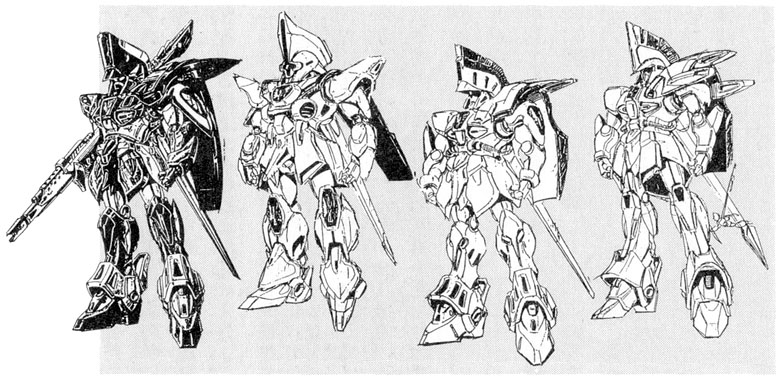
Another one was the Heavygun. This looked "too expensive" and should be made generally cheaper. Picking up the Jegan that was in front of him, Mr. Okawara asked, "So you want me to just connect boxes together?" (laughs) "I'll try to come up with something," he said, and went on his way. The Gundam and the Vigna-Ghina were left until later.
Having come this far, what about the weapons? It would be boring to just have beam rifles and sabers. How about this? I suggested a spear that could be launched. "What if we did that," the director said. "Do you understand, Mr. Okawara?" "Yeah." (laughs) Mr. Okawara and I were both visualizing the pile bunker from Votoms. The completed version was large overall, and held in the right hand since it was the main weapon. This became the shot lancer. Looking at it, the director said, "It would be good if the tip could be launched, wouldn't it?" Yes, that was fine, I answered. At the time I hadn't thought of launching just the tip. (laughs) Afterwards, the director said, "The problem is that it won't be a spear anymore after it's launched. Here, if this is like a pencil cap..." Aha! "That's fine, as long as it only flies a short distance." And so it was decided. (laughs)
As the mobile suit work continued, the third script draft progressed in parallel with the storyboards. All the parts that had been storyboarded had been delivered, so the first 90 pages were more or less fine already. (9) Separate work began on the second half, which would be scripted prior to storyboarding. This started around the beginning of March, and one way or another we wanted to get it done during that month. The storyboarding was scheduled to end by May at the latest. Isn't that right, Director Tomino? "Sure, that's right. (There's no chance we'll be done, is there?)" (laughs)
Most of the characters were approved in the first round. Mr. Yasuhiko's drawings were always very reliable, and he had also participated in meetings about the script and the featured characters. At the studio, the director discussed the characters one by one. "This person is really an otaku." "This character should seem a bit like a punk chick." Here, by way of mood reference, the director showed us photos from Western magazines like "Newsweek" and "Number," with the faces of soldiers and completely anonymous people. There were lots of these unique pictures. When I handed this over to Mr. Yasuhiko, he said, "Oh, I have this book," and kept on drawing. I was rather impressed that these old guys were so well-read. Anyway, Mr. Yasuhiko was steadily producing characters.
The director may be contrary by nature. Looking at these characters, he said, "It's no fun if the characters are just as they seem, is it? That's the secret of Gundam." As he said this, he acted out how the punk chick was a really good girl, and the swift actions of the otaku-like character. "It's boring to see an ordinary otaku, isn't it?" I see. But it would be dangerous to speak so frankly outside this room, director. "It's fine! We should depict them as people who work in earnest, so people won't make fun of them for being otaku!"
As the storyboarding progressed, the mecha and characters were also being completed. Next, now that it was a concrete production, we would hold animation meetings and begin the actual work. That was roughly the stage we'd reached. It was a big process.
Tomino storyboards are pretty funny. He talks to himself, writing things like, "Hm, if we do this here, then yes, it means something like that." As well as his own monologues, he also includes various requests and instructions. "Since we're doing it like this, take care of it, Inoue." (laughs) Notes to the scriptwriter, Mr. Ito, were written throughout the storyboards. "This used to be that kind of narrative, but I tried to summarize it through this kind of process. I did it this way with that intention."
He also made specific requests. For example, after the heroes have fled Frontier I, a bird flies by in the foreground while the Space Ark is entering the forest. He wanted to use strange things, saying "Please make this a black-crowned night heron" and "This is a flower called Dianthus superbus." After this, a hokakeinko appears. (10) The director once saw a photograph of this rare bird and kept it as a clipping. "This flies by," he said. But whichever book we looked it, it only had that same photo. We asked an expert, and they said it was so rare that virtually no other photos had ever been taken. When we told the director we couldn't make it move, he said "One way or another..." The structure of the wings should be identical to those of other parakeets in flight, so we just added the details to that. It's an interesting example of something that should be impossible without photos, but we were able to do it in animation.
And then, the electric wheelchair... that's not in there either. There were many such small details. In his storyboards, Director Tomino wrote that, "The scooter Monica is riding is a foldable type." Is there a scene where it folds up? "There isn't. But it's still a foldable scooter!" There were many cases like that. But where do these requests come from? "It's a game, a game," he said. "But it would be boring if everything in that world were completely standardized."
There were also various ele-cars and military vehicles, with many detailed explanations and requests such as, "Please make this and this different kinds of missile truck" and "This is like Japan's Type 87 Command Communication Vehicle." I ran back and forth to the library, and I went to bookshops, but I couldn't find it. Finally I had no choice but to check it on video. I couldn't find a state-of-the-art pattern since it was a military secret, so I went to a place that had industry-related pamphlets, and I included those as well since were doing that sort of thing.
After that... there were performance requests. This person's words should be spoken like this, their head should be turned in another direction. If there were people who look away while talking as well as people who always speak to others directly, so that there are a variety of behaviors, he said it would create "individuality." How many of these orders were there? It might be interesting to try and count.
Up until Gundam ZZ, we had had an expert performing SF research. This time, it was more like a family story than science fiction. But still, it was also a robot show, and so weapons were involved. Thus we sought the cooperation of someone with a manga-like approach, and the manga creator Kohei Nishino ended up joining the staff. He was someone who loved military matters, and performed research and SF research for other artists when they were drawing their manga. Mr. Nishino provided us with many ideas, and became a powerful force supporting the creation of Gundam F91.
Various ideas then came from Mr. Nishino. For example, trying to show team battles. Up until now, mobile suits just flew around attacking and exchanging shots one-on-one. This time, the mobile suits should be in formation, with several machines acting together. One could deliberately attack as a decoy, or the commander machine could be constantly watching over the other two, which would intervene when it was in danger of being hit. He thought it would be interesting to add these nuances. Come to think of it, up until now we had simply had commanders, and they hadn't done any of these kinds of things. As it happened, at just that point, the director went to see the filming location of the movie "Heaven and Earth." Seeing how the armies moved, he said it would be interesting if we could show this effectively.
Various other people also participated this time. There was someone in America who was like Director Tomino's private brain, and he had this person create spellings for all the characters and mecha which appeared in Gundam. One difficulty here was the heroine's name, Berah Romah. "Bella" had the meaning "great," and the director said that he'd given Berah this name on purpose. But it seemed "Romah" sounded like "Rome," and so "Berah Romah" simply meant "the great Roman Empire." Rome wasn't in Babylon, was it? Nonetheless, it was hard to abandon the sound of "Romah family." Saying there might be another way to phrase it, the foreigner suggested the name "Ronah." Berah Ronah was satisfactory, and so it was changed.
Tess Fairchild was another example. "Tess" was a female name, which had been unintentionally given to the character. It was hastily changed to the masculine "Theo." However, "Tess's Bread" was written on their ele-car. Since the animation work hadn't yet begun, we discussed whether we should change it. But when we met with the director, we decided Theo could have done this because it was the name of his own former lover, or because he had an Auntie Tess who used to make the bread that he was now making. That seemed pretty deep. So we decided to go ahead as it was.
For "Leslie," rezurī sounded better than resurī. As for what was originally called the "Crossbone Ban," you wouldn't really say that in English. "I did that on purpose," the director said. But when we send it overseas, it would be problematic if it didn't have a proper meaning. So at first, there were various ideas like "Crossbone Bandit" instead of "Crossbone Ban." Since "Vanguard" means "advance guard," the director went with that, and they became the Crossbone Vanguard.
We had now begun animating, but every time the location of a single cut changed, the background art had to be replaced. Mecha appeared one after another, and various objects and countless people were running around in the streets. This was tough for everyone, but noneless Mr. Yasuhiko and Mr. Okawara were drawing at a very fast pace.
Left: Early designs for Dwight, Rees, and Dorothy.
Right: Jegan renewal designs by Junya Ishigaki, who was now in action.
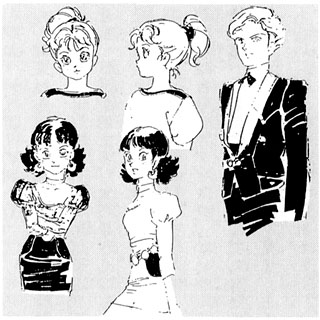
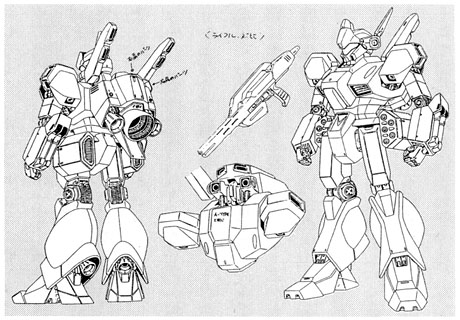
However, there came a point when there simply wasn't time to design all the mobile suits that appeared at the begining. Mr. Okawara's health was beginning to suffer, and from this point on, he was feeling overworked. (After all, he wasn't just doing Gundam.) And there was still a lot to do. On this Gundam project, there was so much that people looking at it would say, "Just how many movies are you making?" Enter Junya Ishigaki. Though he'd made his debut with Exkizer's enemy mecha, this youngster had been with Sunrise's planning office for three years. As he assisted Mr. Okawara with his work, Mr. Okawara in turn cleaned up the things that Mr. Ishigaki drew, and now Mr. Okawara was training and guiding him as a mentor.
Anyway, we requested that Mr. Ishigaki simply remake the Jegan. Up until now, he had been watching Mr. Okawara at work. He asked, "Do I have to draw something that great?" Then he made a Jegan A, B, and C. That's Mr. Ishigaki for you. He deliberately reworked parts of the Jegan from Char's Counterattack that were fairly smooth to give them a hard-edged feeling, and gave the nozzles and thrusters an Okawara style. His drawings were approved as is. But Mr. Ishigaki couldn't do this in such large quantities either.
There were also various fine details related to background art, such as the additional detailing of warships, and the art director Mr. Ikeda couldn't keep up with them. It felt like a reception hall or a government office. (11)
There were also two colonies, and various things inside each warship. So I asked the director, couldn't we do something that would allow us to reuse previous materials? He replied, "That's fine, as long as it makes historical sense and feels more cinematic." The director also began incorporating this into his storyboards, and out of sheer necessity, the ships that were destroyed at the beginning of the director's storyboards became Salamis Kais in the final movie. And so the Salamis Kai appeared... the idea was that these were moored ships that were no longer used. After all, they were built about 30 years earlier.
A ship called the Ra Gusta also appears in this story. This is the fourth or fifth ship of the Ra Cailum class. There's also a new ship called the Space Ark, which was initially supposed to resemble the Pegasus class. However, the director said, "I want it to enter the colony." Thus we had to make it a smaller vessel. The White Base once entered a colony, but actually its size would have made this a very tight fit. With its wings spread, it would really have been too big to enter. This time, we decided to make it a training ship small enough to fit inside. Since the Ra Cailum was already in use, we said this newly constructed warship was a training ship adapted to the Ra Cailum. Its size was completely different, but it was still furnished with a complete set of small anti-air machine guns and something like main guns. At that point it was approved.
After that came the fine details of things like the enemy ships. There were lots of close-ups, and the background art was more detailed than before. For example, weren't the handles that mobile suits turned actually mecha? This, too, was difficult for the background artists. By this point there really wasn't enough time. It was nice that we could use the Ra Cailum's interiors for the Ra Gusta, but there was very little else we could reuse. In the end, we needed a person to serve as detailer.
The person who came to help us at that point was Kazunori Nakazawa. Three years ago, Mr. Nakazawa had actually played a major role in the creation of the Nu Gundam, doing the base design and then adding various details.
All the materials were ready, and now came the animation... This was also very hard. A variety of people were performing in the foreground, and running away in the background. The director's orders regarding performance were extremely detailed. For example, in the first storyboards, when Sam descends into the space boat carrying a bazooka, he comes down with his back turned to the ladder. This is generally how a professional like a construction worker would descend. You can quickly descend a ladder while holding it behind you. Ordinary people, on the other hand, would hold the ladder facing the other way. During an animation meeting, an animator said, "You wouldn't normally do it this way, would you?" The director replied, "Eh? I made it this direction in the storyboards, but... Oh, I see," and fixed it immediately. In later animation meetings, there were parts where we'd say, isn't it a little weak if it's like this? The director would say, I see! Right, then! "Excuse me. Please wait a little longer before we discuss these ten cuts. Please make make this a lily flower. Is there setting? Inoue, take care of this later, right?" Okay. (laughs)...
Sometimes, in response to the drawings the animators brought him, the director would begin by saying, "That's not right." Then he'd tell a production assistant, "Come here a minute." Yes, what is it? "Kneel down right there," the director would say, suddenly holding their head in his arms. "I see, when you hold a kneeling person, the angle of the arm would be like that." Then he'd start drawing, and tell the other person "Okay, that will do." (laughs) (12)
In fact, even if you perform it in your head, it may not work in reality, so you have to try it and see. So the director would suddenly start walking. Tap tap tap, try something like that. Then he'd deliberately sit down somewhere without a ladder and fall down. All these scenes are in the movie. He'd suddenly start yelling, "Yaaah!" Wh-what is it? "When you're angry, you don't raise your hands," he'd say, and begin drawing. (laughs) There were a lot of false alarms. (laughs) It was amusing for everyone. But depending on the situation, there were times when it wasn't so amusing. (laughs) The director's behavior was pretty amazing.
When we started adding colors, at first the Gundam's chest was white. Then someone from Bandai asked that we make it a bit more colorful. We asked if they had any ideas, and we got an awful lot of them. They'd tried every possible color, including a green Gundam. "Well, it may not be useful as reference, but this is what a flashy one would look like." It certainly was flamboyant, we agreed. Simply making that one part blue gave us our current Gundam.
When we entered actual production and cuts with the Gundam were completed, they asked, "How should we paint this?" The front of the Gundam was blue, but the back was white. When it was viewed from above, there was no interruption in the lines. So I hastily added a line there, and said, please do it like this. I'll let the director know later. "Okay, so you added a single line," the director said. Anyway, that's how we were able to separate the colors. And that's why, in the early announcements, the color separation in the back view of the Gundam doesn't actually work unless you add a line.
At first, "F91" was "F-91" with a hyphen. When it became "F91" the hyphen was removed, but it was included everywhere in the parts made as an initial test. That's a mistake.
It's finally time to discuss the F91 and Vigna-Ghina. As I previously mentioned, the creation of rough drafts of the F91 essentially began in April, and by July or August Mr. Okawara had completed an attractive design. (13) Then a problem arose. It wouldn't have been a problem if there were a new program in the spring, and at that time, we were planning to release a new Gundam to the public in April of the following year—that is, April 1990. In that case, the Gundam works would continue. And until then, there was "War in the Pocket."
But when the project became a movie, it was postponed a year. There would be a one-year blank. Then Mr. Okawara said, "Bandai asked me to create some kind of super Gundam, as a culmination of Gundam. I've been drawing it, but the concept is similar to this one..." At the time, he was working on the F91 that we had requested from him. It was the one simply called "new Gundam" that he had previously brought to us. Since we had no other choice, we talked to the director and to our grand producer, and decided to repurpose it.
Since the 91 would appear in 1991, it seemed fine to have an F90 that would be released in 1990. In short, we decided that the 91 was the first F9 unit. The F9 would be a Gundam series developed at a different place from the previous RX line. Thus Director Tomino came up with SNRI, and we went ahead with the F9 idea. Since there was a first unit, it made sense that there would also be a prototype, so the F90 could be unit zero of the F9 type. In other words, it was a testbed prior to receiving the number "1."
In the development of real-world American aircraft, the X series are purely experimental aircraft for technological development, while the Y series are test aircraft for practical use. There were a YF-17, -14, and 15. There was also an X-15 in the X series, but it was used only for technology development to find how much speed could be produced by attaching fins to a rocket.
This time, the F number indicated a machine intended for subsequent mass production, but the F90 was a purely experimental machine. Until now, there had never been a Gundam of this type. Though the RX-78 was changed when it became the mass-production type GM, it had nonetheless served as a prototype. This time, it was truly an experimental machine, of which only two units existed. We thought it would be interesting to do something like this with the F90.
In order to turn it into the 90, a variety of mounts had to be added. It had protrusions and indentations all over. Thus the Formula 90 was created. We had various ideas, and we wanted a Guntank and of course a Guncannon. The aerial invasion A type, the S type, and the D type were each created in December.
Next, we discussed what to do about the 91.
Right! Let's make some changes. Eliminate the double intakes on the chest, get rid of the V-antennas entirely, never mind what the calves look like! Then we tried drawing it... and it didn't look like a Gundam. So Mr. Okawara kept the calves and the V-antennas, and changed the chest. Next he completed a rough with things on its back like the shelf nozzles attached to the Berga-Dalas, and a completely different design for the shoulders. This took until February, and it became the template for the current F91. Instead of double intakes on its chest, it had an absurdly big thing like the grill of an automobile. If you covered its head, it didn't seem like a Gundam.
The director said, "It's good, isn't it? We can go ahead with this." The grand producer, President Yamaura, who had been with Gundam ever since the beginning (as one of the planners of the first Gundam), also looked at it and said, "We had to change it this much, didn't we?" Because new Gundams would be starting from here, we wanted something simple but unusual, with a variety of changes so extravagant that it would be impossible to change it any further.
And there was one more point. We also gave it a mouth. We tried adding it, and then considered how to show it. Up until now, no Gundam had ever had a mouth, but it wasn't so ridiculous for it to have one. No matter much people had tinkered with the Gundam, its face alone had never changed. If we were going to change it, it could only be now, when all the original staff had been reassembled. Thus Mr. Okawara began drawing.
Left: At first, shelf nozzles on the back were being considered as the Gundam F91's weapons.
Right: A rough for animation reference by Mr. Yasuhiko.
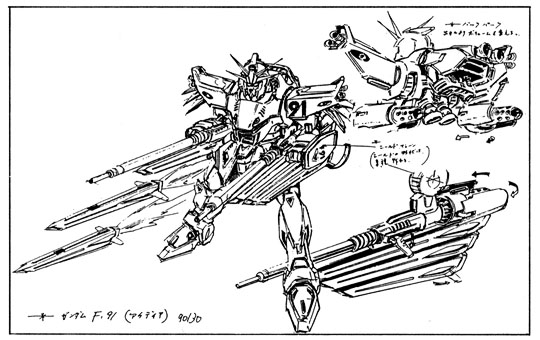
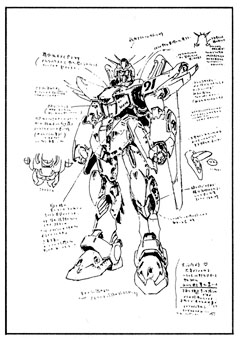
For various reasons, the Gundam alone had fallen further and further behind schedule. We began animating in February, but the Gundam still wasn't ready. I went back and forth between Mr. Yasuhiko and Mr. Okawara, and somehow managed to get it from Mr. Okawara in May. By that point Mr. Okawara's health had become extremely poor.
After finishing up all the small items aside from the mobile suits, Mr. Okawara was hospitalized in July. (14) He'd completed the Gundam, and had barely managed to finish Berah's machine as well. Perhaps that was a mistake. When I called Mr. Okawara at home, he said he had a cold, and was working too hard even though he shouldn't. He was feeling dizzy, so if he went to the doctor they might hospitalize him. But if he stayed at home, he'd just end up going back to work. After that, I asked Mr. Yasuhiko, "Would you like to draw a collection of Gundam poses?" "I'd be hospitalized too," he replied. (laughs) It was tough for everyone.
Yet another problem arose in June. The director had finished storyboarding, and asked the question, "What should we do for the ending?" "I'm still not satisfied," he said. "I want to make flashier scenes for the movie." He invited everyone who was available, including the art director, producers, unit directors, animators, and Mr. Nishino who later joined the staff. The topic was, "Is there anything you'd like to see in Gundam? Everyone, please say whatever you want."
Translator's Note: The subsequent description of this meeting seems a little unclear as to who is saying what to whom, but I imagine it was confusing at the time!
The director said that this time, he'd be the one doing the listening. And everyone did say whatever they pleased, like how there weren't any fleet battles, and, "We came this far, and now you ask us what to do?!" (laughs) As Director Tomino might put it, "Who do you think is going to fix these storyboards? I am! So how much do you want?" (laughs) But he didn't really say that. (laughs) Instead, he said, "What, you think it's somebody else's problem? You're the ones drawing it."
"We'll put in the parts everyone wants to see. Should we go to the trouble of having beams break through the colony's ground surface from underneath?" The director protested for the sake of protest... After that, we naturally wanted the hero to get all fired up at the end, and of course since it was a happy ending, then maybe a love scene? "Hm, that might be good." (laughs)
We also wanted an awesome weapon to be used in the ending. We'd been discussing this since we were making the colony model, and we wanted an idea for an enemy design to appear at the end. Having fretted about this for four or five months, we asked everyone about it, and they said it might be interesting to borrow something from mythology. This led to the idea of a Medusa-like mobile suit called the Medzack, followed by an ultimate weapon resembling a flying saucer... this became the Bug.
The idea of the Bug came from Mr. Nishino, who also made ridiculous suggestions like enemies that gobbled up mobile suits. (laughs) Surely that isn't Gundam-like? "Gundam is a robot show," said the director. "It's fine for a robot show!" As a director, he started asking questions like, "Would it be weird if it separated?" (laughs) This went on for three endless hours. Then, saying, "I understand! Right, I'll handle it from here," the director took over.
After this meeting, he went back to work and began tinkering with various things. In the middle of this process, the director abruptly came to me and asked, "Couldn't they kiss in outer space? For a moment, they touch visor to visor, then they open them up and meet perfectly..." But the designs are already finished. "Then it can't be helped. We'll just have them embrace each other." And that's how the last scene was completed.
So, prior to that, we decided to be as shameless as possible. When Seabook looks, he sees a lily flower spinning in the distance, and Cecily is floating in that direction. (laughs) Also, what if we don't show the part where Iron Mask dies, and at the end somebody enters a pitch-black room and picks up one of a bunch of iron masks? "That would be embarrassing." (laughs) Well, that wasn't going to work, so the director went and revised his storyboards once again. By the beginning of August the storyboards were finally done, but the ending was still somewhat incomplete. (15)
Wasted detail. The Thousandth Jupiter was cut for schedule reasons.
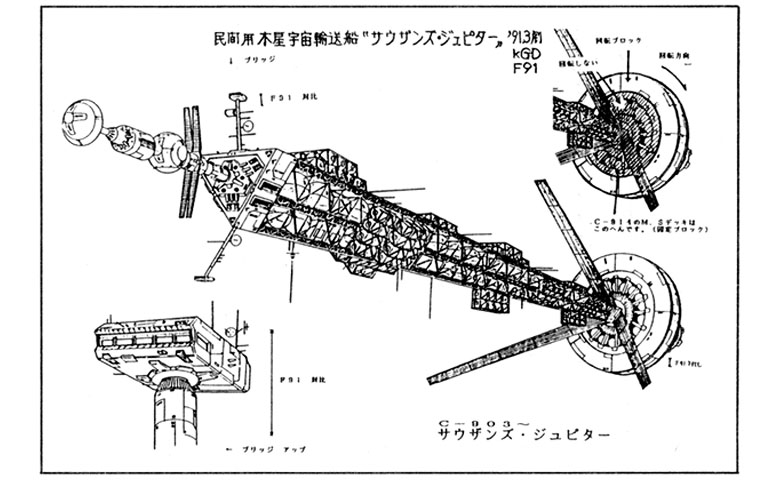
After that, Mr. Okawara was hospitalized, so the Bug and Rafflesia were left undone. There was also the so-called Thousandth Jupiter, but this only appeared in five cuts, so we decided to delete it. As for the Bug, there wasn't even a design rough. The director said that he couldn't storyboard it like this. I asked him what it was like, and he began drawing at once... wasn't this rough good enough? "I said this was purely an image sketch," he replied. So we asked Mr. Ishigaki to handle it.
The Bug's design evolution. The two sketches on the left are Mr. Ishigaki's roughs, and the two on the right were cleaned up by Mr. Okawara.
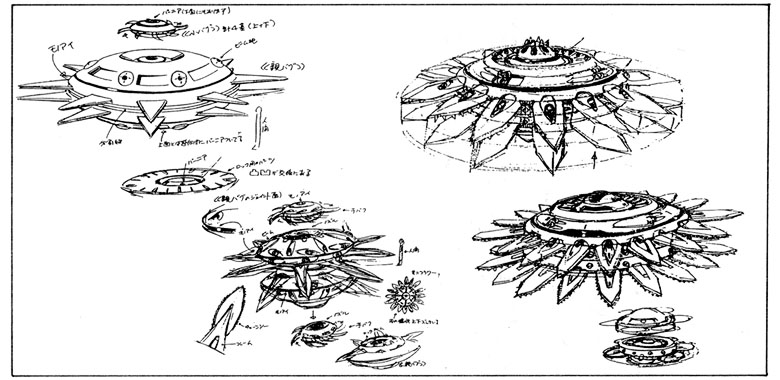
Aside from the Bug, we also entrusted him with the Rafflesia, which at that point was codenamed Medzack. I asked, is it like a Hizack? No, "Medzack" was just the first thing that came to mind. It's something like this, the director said, and drew a rough. Mr. Ishigaki then drew it for us, and also did a few roughs of the Bug, getting it to more or less its current form. The Medzack was also taking shape, but one day the director came to him with bowed head, saying "I'm sorry. The Medzack is too cool." So what kind of thing was it? That's still a secret. Please look forward to the upcoming F92 and 93. (laughs)
The director proposed the so-called Rafflesia instead, which was basically the same thing as the Medzack. With revisions here and there, the Bug and Rafflesia were completed in about a month. Now I can draw the storyboards, the director said, and completed the final climactic part.
When Mr. Okawara was discharged from hospital, Mr. Ishigaki nobly said, "Mr. Okawara is the only one who can clean these weird things up to match the Gundam world. Please ask him to do it." (laughs) So I went to see Mr. Okawara with the roughs, and he did one more and then finished the cleanup. The setting work was finally done.
Rafflesia roughs. (laughs) Director Tomino's image sketch is above, and Mr. Ishigaki's design below.
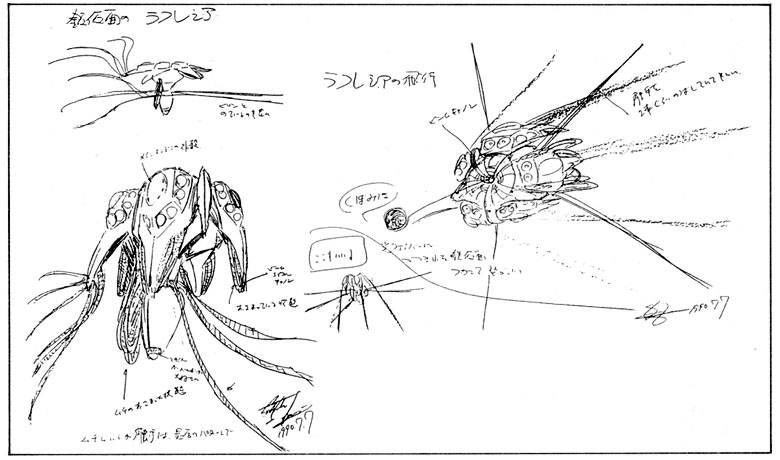
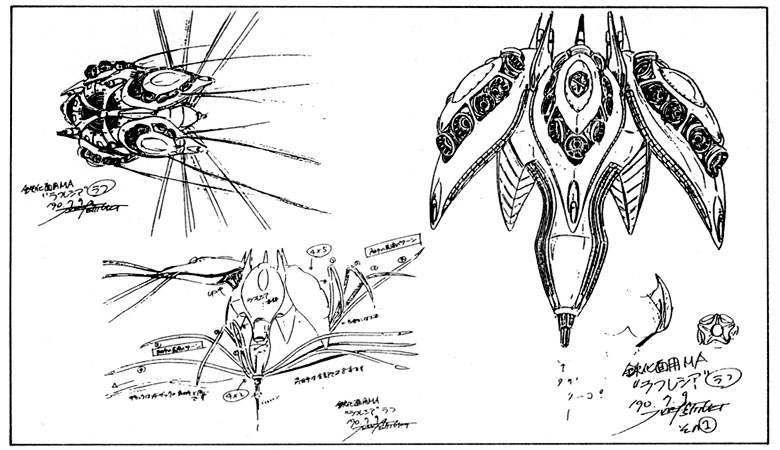
As for the characters, they were mostly finished by Golden Week. But after that, Mr. Yasuhiko would occasionally come to visit the studio. On those occasions, the animation director would catch Mr. Yasuhiko as he was passing by, saying, "There's a character I don't quite understand... I can't see this person's feet." (laughs) Ah, I see, Mr. Yasuhiko said. "If you sum all this up for me, I'll draw it all later," he said, heading home. As a result, he found himself frantically drawing even though his manga deadlines were approaching. Nonetheless, he drew it all, and thus the character setting was completed in July.
And then, the background art. This also had to progress step by step. For example, the area close to the central axis of the colony cylinder is an alpine region like those on Earth, and the atmospheric pressure is lower. Since there's always a wind blowing in one constant direction, the director pointed out that the pine trees there should be windblown in the same direction. After consulting with Mr. Ikeda, I went to take photos of a short windbreak growing on the coast, and showed them to the director. "Not like that," he said. So what sort of image did you have? "Office AI has a beach house. (16) It's close to that..." Then why didn't you say so earlier! (laughs)
I had to head out with Mr. Ikeda right away. "What, we're going location scouting?" There were plenty of pine trees growing all around there, all of them short and windblown in one direction. I see, so that's it, I said. We also discovered that the scree slope in the director's storyboards might be from this location as well. We'd taken photos and could draw it now we'd seen it, so we headed back. On the way, we soaked in a hot spring (it was quite a beach house!) and enjoyed some citrons from the garden. When he saw what we'd drawn after we got back, the director smiled and said, "It's different when you've seen it, isn't it?" But Mr. Ikeda muttered, "As long as you know what kind of thing it is, you can understand it and draw it without having to go see it!" (laughs)
Around October, the background art work was finally completed as well. After this came the background art boards, and the colors of the Gundam and the characters were decided, taking Bandai's requests into account. As they were being decided, Mr. Yasuhiko showed up, saying things like "This color here is terrible" before going back home. When they heard this, the color designer said, "Agh! Jeez, that old man..." but they still fixed it. That's how it felt as the work progressed.
Incidentally... By the time the director had finished the storyboards up to about cut 700, there was a scene where Iron Mask made a speech. In the storyboards for this part, Iron Mask somehow launched the blade on his head. (17) This setting wasn't used, but later on, he attaches a different blade that enables direct brainwave control of the Rafflesia. According to the setting, this should merely have been a connector, but in this scene he launched it like the Eye Slugger to intercept an explosive shell... (18) "Are we really doing this?" the unit director said, to nobody in particular. "He drew it in the storyboards, so I guess we're doing it." Somebody said, "How about this?" "It's embarrassing..."
Translator's Note: Once again, the dialogue attribution is a little vague, and I've made my best guess as to which lines belong to Tomino and which to the unnamed unit director. The comment about it feeling like a manga seems to be from Inoue himself.
When the director appeared the next day, after he'd finished his checks and was about to head home, the unit director said, "Director, perhaps you're not familiar with Ultraseven." Pointing to the storyboards, he asked, "Are we really doing this?" The director replied, "That's what I drew, isn't it?" He was asked again, "Do we really want to do this?" "...It's weird?" The unit director quietly nodded. "It is that weird?" (laughs) No, if you want this to feel like a manga. "It's really that manga-like? Hmm, I understand. I'll think about it." So saying, he went home, and a week later this sequence was removed. This was one incident that happened around June. That was strange.
Left: A phantom setting that has regrettably disappeared. Iron Mask's Eye Slugger!
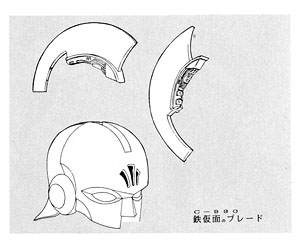
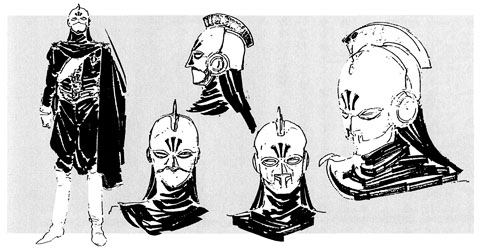
In terms of setting, the introduction of new things such as the beam shield and beam flag inevitably leads to questions such as how they're constructed. When the director came up with the idea of doing things like this, no matter what they were, he'd declare that nothing in the world was unexplainable, and the director can do whatever he likes! That was my own policy when I was working as a setting man, too...
The Gundam's duplication technique and its mouth were tricky subjects. (19) If the mouth opened, then of course we wanted it to shout. The director said, "It's shouting, but for what reason?" ...Cooling! "I get it!" In short, this time it was using a bio-computer, which employed a neuron structure to create something like the cells of a living organism using biotechnology. In the truest sense, it was something close to a brain. In that case, it would naturally use conductive elements made via organic synthesis, perhaps a high-protein compound. (20) Thus it would be vulnerable to heat, making forced cooling necessary. This seemed to make sense. It was a bit of a stretch, but at the idea stage, the director made the instinctive prediction that this would work as a rationale and decided to use it. In this respect, it was different from other robot stories. There was also a rationale for using projectiles alongside beam shields.
The F91's design at a stage where it was largely completed. The VSBRs, the fins, the shapes of the thrusters... After repeated revisions to the details, it is approaching the final version.
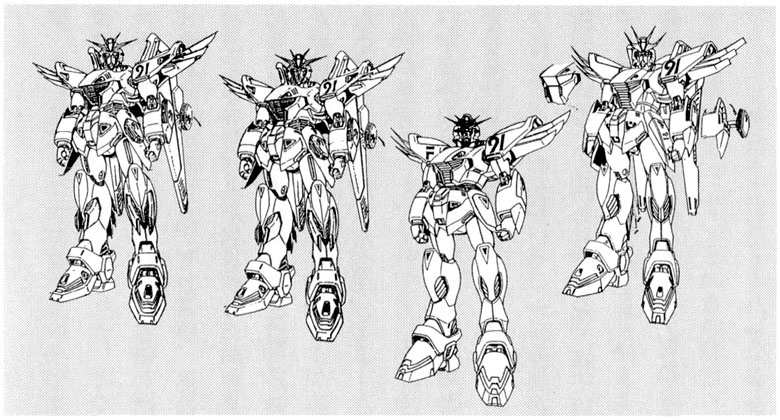
Then there was the matter of the Gundam's duplication. That was really troublesome. This was at the February stage, when close analysis of the Gundam itself began. When Mr. Okawara first created the F91, he expressed the opinion that he'd like it to have multi-layered armor. When it was hit, the surface would slough off like sunburned skin, producing the next action. This was a further evolution of Chobham armor. The impact was diffused across the entire surface, and only the outer layer was shed. It would only be as thick as paint. Mr. Nishino did an initial sketch of this concept, calling it a Jūnihitoe Gundam. (21) Unfortunately this resembled Princess Kaguya (laughs), but the idea must have been somewhere in his head. Anyway, we decided this discarded portion was the shadow.
In space, you'd need a catalyst to dissipate high heat, and when this was emitted it would remain in place. This would be some kind of extraordinary microparticle, left behind along the path of the Gundam's high-speed movement. If this emission were intermittent, like a thermostat turning on and off, then it might leave afterimages. When we were considering this, the director said, "Well then, it's a phenomenon where the surface membrane peels off." Yes, something like that... Then it's settled! We can do it with a clear conscience. We already have Minovsky particles, so the rationale works. (laughs)
Later, we decided that the color would also change slightly depending on the temperature at the time of emission. Likewise, in the beam flag, particles of precious metals like magnesium are released into the air and then a laser is fired into them, and as they burn up they leave a flag behind. Assuming that the same thing is happening on the Gundam's exterior, then it's feasible if we think of it as a kind of ultra-high-temperature plasma rather than a beam. In that case Gundarium alloy must be a really durable metal, right, Director? "Yeah, it's durable," he said. "This is the future, isn't it?" (laughs)
And that's how the F91 was completed.
A "high mobility type Gundam" that was being considered at one point. The form on the left changes to the one in the center (by Mr. Ishigaki). On the right is Mr. Okawara's design.
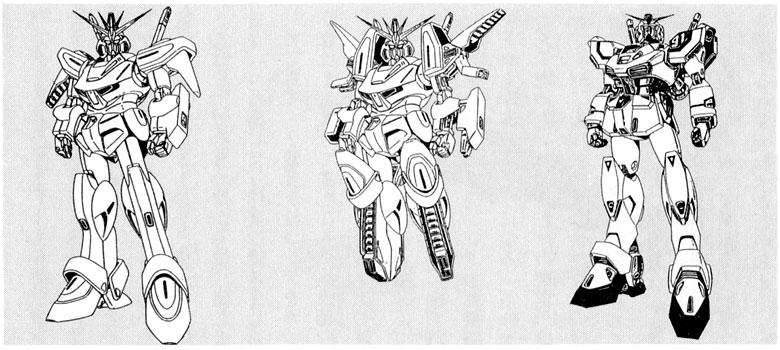
A variety of people exhaustively considered the rationales for the fine details of this work. In fact, precise explanations were devised for all the things you see on the screen.
Of course, making animation is a task that proceeds by creating one picture after another. It's the product of intense concentration by countless people—the drawing staff, the painting staff, the staff who put it all together, however you choose to define it. The best way to reward them, I think, would for you to watch and enjoy this movie.
(1) In other sources, this design is dated to August 4, 1989.
(2) The original text says "chiri" rather than "miri" (millimeters) but I think this may be a typo. Relative to a six-meter space colony, a mobile suit would be about 3mm tall.
(3) Technically this should be more like 3 kilometers wide. The scroll that Inoue is showing off in the accompanying photograph does seem to be fairly narrow, though.
(4) According to the "Gundam F91 Perfect File," the second script draft was completed in February 1990.
(5) Based on the cover image shown in this article, Tomino began storyboarding this opening sequence on January 26, 1990.
(6) In other sources, these designs are dated to October 1989. So although this conversation took place in December, Inoue's delivery of the reference material must have been around the beginning of October.
(7) In other sources, the first and second drafts of the Crossbone Vanguard officer mobile suit are dated to late September and early October, 1989.
(8) In other sources, the first drafts of the Guntank and G-Cannon are dated to early August, 1989, and the second draft of the G-Cannon to late September. If Inoue is referring to the second draft here, this would indeed be around the same time as the enemy mobile suit designs discussed above.
(9) In the fourth script draft, page 90 is about the point where Seabook and his friends have boarded the Space Ark, and Cecily is about to meet with Meitza Ronah.
(10) I'm not sure exactly what this bird is, but it seems to be some kind of parakeet.
(11) There are locations in the story labeled as "reception hall" and "government office," so Inoue may be talking about Ikeda's assignment list here, but the Japanese phrasing doesn't seem to indicate that. Just in case, I left it as a direct translation.
(12) It's a little vague, but I think the hapless "production assistant" who becomes an unwitting model in this anecdote is another staffer, rather than Inoue himself. The scene in question may be where Seabook holds the body of his dead friend Arthur.
(13) The dates mentioned here are all in 1989, as discussed earlier.
(14) According to the "Gundam F91 Perfect File," Okawara was in the hospital for about a month.
(15) The final page of Tomino's storyboards, as reproduced in the laser disc liner notes, says that the first draft was completed on July 17, 1990, and revised on September 24.
(16) "Office AI" appears to be the name of Tomino's own production company.
(17) This scene was originally cut 990, as reproduced in the recent Ultra HD Blu-ray edition.
(18) The "Eye Slugger" is the finishing move used by the hero of Ultraseven.
(19) The Japanese term "bunshin no jutsu" would be translated as something like "clone technique" or "clone jutsu" in a ninja manga like Naruto. In the context of Gundam, of course, the term "clone" might be misleading...
(20) The Japanese phrase here, "kōtanpaku no oni," is literally "high-protein demon." I can only assume that's a typo!
(21) Jūnihitoe is a kind of multilayered traditional Japanese costume.
Mobile Suit Gundam is copyright © Sotsu • Sunrise. Everything else on this site, and all original text and pictures, are copyright Mark Simmons.